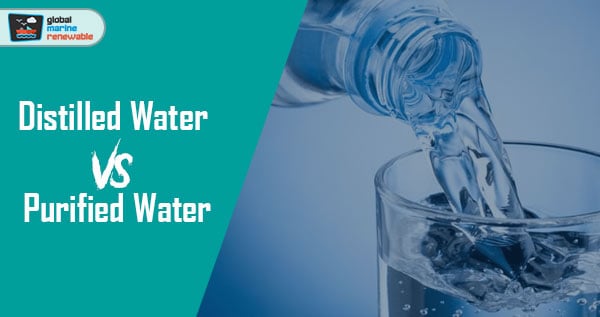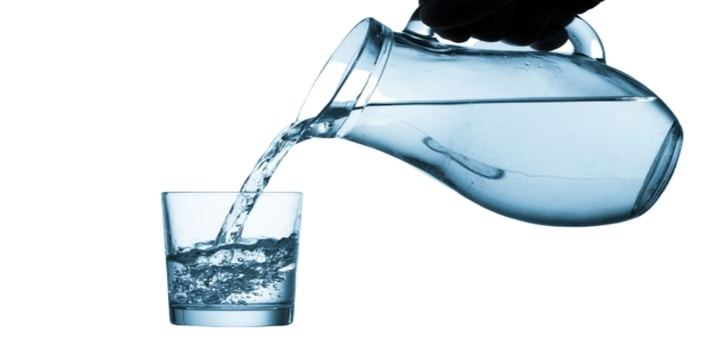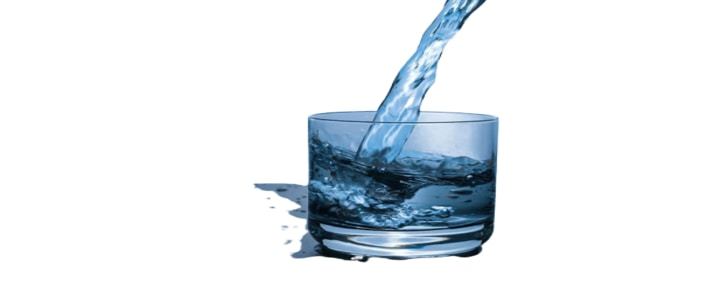
These definitions have always been involved when we talk about the purification process.
The main objective of this article is to know the difference of the process the water goes through, to avoid any confusion.
Each of them has different characteristics and can be used at home or for commercial systems. Likewise, one of them tends to be healthier than the other and inexpensive as well.
Our function is to let you know the advantages or disadvantages of these processes so that you can choose which one is better for you.
Table of Contents
What Is Distilled Water?

Distilled water is a way of purification process which water has to go through; this process is called distillation. You can make distilled water at home.
This mechanism is about a seething process in order to separate its contaminants, capturing the vapor, and condensing it to finally become to distilled water.
After the process is done, distilled water doesn’t contain any impure material such as bacteria because they are removed.
So basically this method is to drive apart all of the contaminants’ organisms.
Water Distillation Process
Water distillation is a process which consists in use the heat font to vaporize water. It begins heating the untreated water until it gets to a low boiling point so that it can start to vaporize.
The heat of the water keeps in that temperature to maintain the water vaporization while separating the contaminants that are inside to avoid its vaporizing as well.
After the water is completely vaporized, that steam is transmitted to a tank.
Once is removed from the heat font, the water gets in environment temperature and then its reverted to its liquid form in order to put it finally in a container and start to use it.
What Is Purified Water?

The process this type of water goes through to reach a complete purification system is way too different from the above.
It includes distillation, ozonation, reverse osmosis, sand filtration, ion exchange, ultraviolet sterilization, coagulation and flocculation, sedimentation, disinfection, recirculation, bottling, activated carbon as well as microns carbon block filtration.
Basically, the principal reason of doing it is to reduce the impurities which is possible during the process by reducing 99% of them.
Regardless of what we have said, it’s important to know that purified water is the best option for our body although it may contain some contaminants.
There are some states that have some demanding regulations than others as a result of having some health problems such as brain damage or stomach distress for drinking this type of water over time with heavy metals in it.
Water Purification Process
There are several methods to purify water. Their effectiveness depends on the contaminant and the use the water will have. The most used are the following steps:
First, water goes through a screening process.
Water from lakes or rivers passes through this process to start its cleaning treatment which has an important function because it keeps the contaminants such as bacterias and others microorganism out of it.
But when the water comes from the ground (commonly rainwater), it is not necessary to use this screening method due to it has passed through earth’s layers which it is said it’s a natural screening.
Then, it passes through a coagulation process. People who work in those plant tend to add some chemicals to the water which cause some sticky particles.
These forms commonly attract others kind of particles which are heavier enough to sink in the base of the water tank.
After that, the water and those particles pass through a sedimentation basin which basically comprises leaving the heavy floc in the base until they are completely removed while the water sits there fluxing to the sedimentation process.
Then, water passes through gravel’s layers in order to filter out any contaminants.
Finally, water goes through disinfection which consists of adding any disinfection’s chemicals such as chlorine to kill any bacteria. Then, it is closed in a tank to avoid any infection process until its distribution to homes or industrial use.
What Are The Difference Between Them?
One way to differentiate them is having this phrase in mind: “It must have less than ten parts-per-million to be classified as purified water.”
Don’t worry, we have got the other reasons covered up too.
System People Use To Get To The Purification
As we could see, to have a distilled water, it has to pass through a distillation operation, instead of purified water that has to go through a large system to reach to the point.
The Way They Are Gotten
Knowing the operation above, we can define that purified water is filtered while the distilled one is boiled.
Presence of Impurities
Distilled is one hundred percent of pureness that means it doesn’t have any impurities or minerals, while purified water incorporates some of them.
Cases In Which You Can Use Them
Purified water is used for laboratory testing, laser cutting and automotive uses.
On the other hand, distilled water is used for experiments and cleansing activities, that’s the reason why it has been considered not a good option for the body.
There are also two more types of water such as mineral and spring water which have different minerals like iron, calcium, sulfate and potassium.
They are used for a different reason as well, but the most commonly used water is the purified for its properties and the distilled water for its pureness.
Difference Between Distilled And Purified Water FAQ
Q1. What Are The Contaminants On Distilled Water?
They are inorganic minerals, volatile organics like pesticides or herbicides and metals.
Q2. Why Is Distilled Water Not Good For Us?
Because this type of water doesn’t contain anything so that it takes the cells to a disequilibrium state. It can also dehydrate the body.
Q3. What Kind of Impurities Are Removed Through Purification?
Principally bacterias. But also, fungi, parasites, algae, chemical pollutants and metals as well.
Q4. What Are The Disadvantages of Purified Water?
One of them is the cost. As we know, this purification process it can be very expensive, and it’s something that has to be done regularly.
Because if those minerals and contaminants are not removed, they can build up and cause serious illness.
Q5. What Are Some Risks of Drinking Distilled Water?
As we know, this kind of operating system drive apart all of the natural minerals that are good for us such as calcium and magnesium, so the lack of them can negatively impact our body.
For instance, people who drink distilled water can have more probabilities to have risks of fractures and heart disease.
Q6. What are some types of water distillers?
Three popular kinds are familiar in our lives. They are;
Household: It is one of the most common types because it can be set in your kitchen or in any place in your company.
It basically consists of pouring measured water into the system, and you will have distilled and filtered water right there ready to use.
Plumbing Distillers: These units can be set at home or in your office, but one of the disadvantages is that it requires some maintenance.
Commercial Distillers: It is used for many commercial industries, containing multiple boiling systems offering you more water quantity at a time.
Difference Between Distilled And Purified Water Conclusion
Before drinking any kind of water, we have to be conscious of the types of water we are going to choose.
Basically, a water distillation system is designed to purify your water in a quick and cheaper way. You just need two things; a heat font and a condenser.
Distillation is commonly used for offering you clean water for your home and commercial use.
It provides water that is 99% free of impurities which makes them kind of popular and cost-effective for homeowners and business owners alike.
On the other hand, purifying water reduces the concentration of microorganisms such as viruses, parasites and bacteria as well, but it doesn’t get completely eliminated.
We have to know which one is better for us and which one has healthier benefits.
Popular Guides: